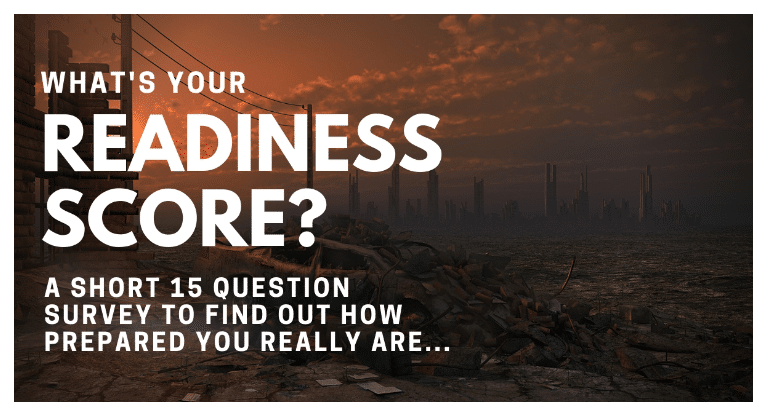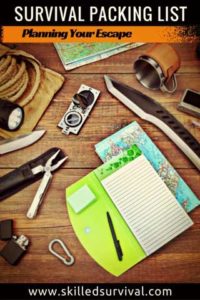
In today’s modern world, it pays dividends to be prepared for all possible emergencies.
From winter power outages to end-of-the-world scenarios.
We can all agree that emergencies have occurred in the past, they happen in the present and will happen in the future.
So it’s irresponsible to stick your head in the sand and pretend that “it won’t happen to me“.
If an unforeseen emergency forces you from your home, are you prepared to leave at a moment’s notice?
If you can’t honestly answer that question with a “Hell Yes”, then you’ve some work to do.
You need to get your “sh*t” together and start building your survival packing list.
Are You Ready For The Tough Times Ahead? Take My 60 Sec Quiz To See If You’re Part Of ‘The Fragile Masses’ Or Not… Start Quiz Now!
Why You Need A Survival Packing List
Are you ready for an immediate evacuation? One where the sooner you leave; the safer? How long would it take your family to go from – lounging on your couch to out the door – with all your essential gear and supplies?
Could you do it in under 5 minutes? Is that enough time? And if you did it in less than 5, would you forget something important?
When an unprepared family is forced from their home they’re left scrambling from room to room. Randomly cramming survival essentials into pillowcases and suitcases.
This leads to crucial items like prescription medications, survival food, extra clothing, and survival gear being left behind.
However, those with a survival packing list and their survival pack or EDC bag ready can leave in mere seconds. Knowing with confidence they have absolutely everything they need.
Shouldering their emergency pack, tossing it into their bug out vehicle, and getting the hell out of dodge fast.
When time is of the essence, a survival packing list is your answer.
7 Reasons Why EVERYONE Needs a Bug Out Bag
Exclusive Bonus Content – Skilled Survival’s 104 Item Bug Out Bag Checklist – the only bug out checklist worth using. Click Here To Get Your FREE Copy Of It.
Different Types Of Emergency Bags
Before you start building a personalized survival packing list, you need to understand the difference between short-term and long-term emergency needs.
For a short-term emergency, you need a small bag that includes enough supplies to last you and your family a day or two at most. Enough supplies and gear to go it alone until relief services arrive.
A long-term survival packing list includes items that would make it possible (with the proper education) to live independently for weeks or months without assistance.
That requires more gear, more supplies, and more planning.
And for most people, the long-term survival bag is a supplement to the short-term bag.
Meaning, you should prepare both and then pare down or discard the long-term supplies if you happen to not need them.
For more information on the best survival packs click here.
Where to Start On Your Survival Packing List
If you, like most people, do not have access to an unlimited budget, you will need to amass your bug out supplies over time and look for good deals on gear and supplies.
Start by putting together your short-term bag, which is better than nothing if you are forced from your home.
Many of the items you’ll add to your short-term bag may be things that you already own.
Then once your short-term bag is ready it’s time to start building your long-term emergency bag.
Then once your short-term bag is ready it’s time to start building your long-term emergency bag.
Your Short-Term Survival Packing List
In a short-term evacuation scenario, you should focus on your basic survival needs first. Those are the items that will keep your body alive; that’s it. Sorry, luxuries are not essential.
The essentials of staying alive include air to breathe, water to drink, warmth to avoid hypothermia, and medical supplies.
To be brutally honest, food is not essential in a short-term evacuation scenario. And food is extra weight so it will slow you down.
So I don’t recommend worrying too much about food for your short-term packing list. Just toss in a few high calories bars and call it good.
Green Beret’s Ultralight Bug Out Bag
While every family is unique, here are the items most people need or desperately want, broken down by category.
What To Have In Your Short-Term Bug Out Bag?
1. Gas Mask
Not everyone agrees that a gas mask is an essential item on a survival packing list. However, if the air is dangerous to breathe, you won’t last long.
Of course, it’s better to stay put and hunker down in the event of a nuclear attack, if possible.
The last thing you want to do is run around outside breathing fallout.
Your safest bet is to remain indoors with as much concrete and building materials between you and the fallout.
Plus, there are other chemical attacks that can turn the air we breathe unhabitable for unfiltered consumption.
So, if you’re forced to evacuate (because staying is more dangerous than leaving) then you’re going to be glad you invested in a gas mask and some mask filters.
Personally, I’d rather have one and not need it, than not have one and need it. Choking on dangerous air is not something I’m fond of experiencing.
MIRA Safety CM-7M Military Grade Gas Mask
With a MIRA Safety CM-7M Military gas mask, you’ll protect your eyes, face, and breathing organs against:
- Nuclear Fallout
- Biological Threats
- Radiological Agents
- Chemical Gases
- Etc.
This mask also includes a drinking tube system with a free canister.
Unlike other gas masks made of regular Butyl, this emergency mask is crafted from high-quality Bromobutyl rubber.
Making it suitable to use in the temperature range from -30°C to 70°C.
This premium MIRA mask is ergonomically designed and has a wide 180° wide view visor.
It also includes a sweat drainage system and a built-in speech diaphragm.
You can even use the drinking apparatus while wearing your glasses or even a helmet.
This affordable high-end gas mask includes features you’d normally have to pay over $400 for. Making this one of the best affordable gas masks; period.
This is the Gas Mask I own and bought for myself and I love it!
I put my money where my mouth is and that’s the real reason why it’s our #1 choice.
MIRA Safety Gas Masks
2. Clean Drinking Water
If you are weathering an emergency inside your home, a wall of water or a few cases of bottled water will suffice for several days.
However, bottled water is surprisingly heavy and not a suitable option for situations where you leave your home.
Instead, each member of your family (including pets) should have their own stainless steel water bottle, their own water portable filter, and some water purification tablets.
This will allow you to safely drink water you find when you’re away from home.
Many people think they can skip this step because they live in a rural environment and believe that they will have access to water taps or water fountains locally.
This is a short-sighted mistake.
You have no idea which water sources you can trust or not. Just because it comes out of a tap, the emergency that forced you to evacuate may have contaminated all sources of public water.
I recommend you get a portable LifeStraw water filter. Get one for each family member.
LifeStraw Review and Field Test
Water is one of the easiest survival packing list items to prepare for but also the most essential. People tend to take water for granted but you don’t you be one of them.
Without copious amounts of clean water, your body will quickly start reminding you how silly it was to take it for granted.
3. Clothing Gear
In areas where heat is the enemy, desert survival skills come into play. Dehydration and sunstroke are the real dangers.
Packing light clothing and plenty of ways to purify water.
If you live where winters are brutal, you’ll need wool socks, heavy boots, gloves, plenty of calorie-dense food, several methods of starting and maintaining a fire, and a warm sleeping bag, at a minimum.
You should also take the time to learn more about cold weather survival so you can prepare to avoid deadly hypothermia.
4. Shelter Tools
While a skilled woodsman can create a sizable cabin from only natural resources, items that you pack should make the task of creating a survival shelter easier.
Depending on your skill level and expectations, you may want to include a survival hatchet and some 550 paracord.
If you live in an urban area, you may be able to employ some urban survival skills to successfully squat in an abandoned warehouse with no interference.
Others may have to plan to escape into nearby forests and create shelters from nature.
Still, others may be able to rely on breaking into vacation homes or cabins that already exist. Or even better yet, you have a bug out location.
Think carefully about what is available in your area and what you would do if you needed shelter during a terrible emergency.
Everyone’s answer to this question will be different, and preparing yourself with several options ahead of time can save you a lot of useless floundering and needless wasting of energy.
I like packing a lightweight mylar sleeping bag like the TACT Bivvy.
Bug Out Bag Shelter – TACT Bivvy Review
5. Medical Supplies
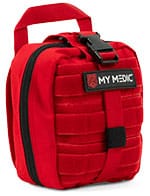
But either way, you’ll want to add personal supplies of any prescription medication used by your family members.
Over The Counter Meds
You may also find it helpful to include the following over-the-counter medicines:
- anti-diarrhea medication
- pain relievers that double as anti-inflammatories, such as Aleve or Ecotrin
- antihistamines such as Benadryl to combat allergic reactions
- a coagulating agent, such as a styptic pencil, to control minor bleeding
- triple antibiotic ointment to seal small wounds and avoid infection
Hopefully, you will never need these items. However, being caught without them will be uncomfortable at best and downright dangerous at worst.
In a widespread emergency professional medical care may be hard to come by.
Your serious injury may be a low priority when compared to others. Or maybe there’s no professional medical help at all.
Maybe all the medical professionals are getting the hell out of dodge too.
So make sure you know how to use the medical supplies you include on your survival packing list.
MyFAK First Aid Kit By MyMedic
The MyFAK kit is our featured IFAK. It has everything you need with incredible design and function.
The MyFAK is one of the world’s best fully equipped first aid kits for all your adventures. It contains all the life-saving supplies for all traumatic emergencies, such as:
- Bleeding
- Airway obstruction
- Fractures
- Sprains
This IFAK comes with 100 supplies for first aid and trauma. Plus lots of standard supplies for smaller injuries.
It’s compact while storing the maximum amount of equipment.
It’s ready to go with you anywhere and comes with high-quality medical supplies—the type of high-grade equipment that medical professionals use.
Including in the design is a rip-away medical IFAK pouch. This feature provides quick treatment of injuries without having to open the entire kit up.
You can store items that you need quick access to in this panel.
Securing the contents is a heavy-duty zipper that will not snag. You can’t have this happen in an emergency, so MyFaK put on the most robust, high-quality zipper they could find.
Inside the kit is a great layout that’s easy to use and access supplies. This organizational structure is vital in an emergency. It opens up in a tri-fold design, so you have everything laid out to see.
On the outside are MOLLE straps and Velcro patches so you can make quick attachments.
This IFAK is the one you want! And you can rest assured it’s made with quality in mind by an industry leader.
6. Food Supplies
In an emergency, people forced from their homes are sometimes left for days before emergency services can get food into the area.
For a short-term bug out bag packing list, you want to concentrate on light, nutrient-rich foods.
While military rations and freeze-dried meals can be good options, they can also be expensive.
Here are some good ideas for foods you can find at your local grocery store at reasonable prices.
- meal replacement bars designed for athletes and bodybuilders
- protein powder
- packets of crackers and cookies for quick carbohydrates
- trail mixes
- dehydrated fruits
- chocolate
While these items are not recommended as a long-term diet, they do provide plenty of sugar, protein, and carbohydrates to give you much-needed energy.
If you need to walk out of a disaster area, you will need all the energy you can get.
Mountain House Food Review – Is This The Best Bug Out Bag
7. Comfort Items
While this category may seem silly when thinking of life-or-death emergencies, many of the items that will keep you comfortable also have multiple uses.
Here are some ideas for keeping everyone in your family comfortable.
Feminine Supplies
Such as pads, tampons, and panty liners. Any females in your family who experience a menstrual cycle may need these items.
If they are not needed for their original use, they can also act as bandages for wounds. Tampons can also be used to stop nosebleeds or you can shred them and use them as kindling to start a fire.
Petroleum Jelly
This can be used to combat everything from chapped lips to blistered heels. It can also be used as a lubricant or to keep bandages from sticking to wounds.
Survival Bandanas
Several survival bandanas can be used to fashion a sling, protect your face and hair from the sun or dust, or can even be torn into strips to use as rope or bandages. Bandanas have a ton of uses and are light, so pack several.
Notepad
A small notepad and a few pencils can be used to jot down directions, leave notes for others or you can use the paper to start a fire.
Playing Cards
Survival playing cards are a great way to stay entertained without adding much weight to your pack. Plus, a good set of survival cards includes valuable survival knowledge as well.
Socks
Spare socks and underwear can do wonders to make an emergency more bearable and hygienic.
You can use a few drops of bleach to wash the ones you are wearing and change them into your fresh supplies.
Grooming Kit
A small grooming kit that includes toothbrushes, toothpaste, deodorant, disposable razors, nail clippers, and a package of baby wipes can help you to feel fresh and comfortable until your next chance to shower.
You may be able to use extras of these items to barter with others for needed supplies, as well.
There are plenty of comfort items you may want to include in your bug out bag checklist, but you also need to keep an eye on how heavy your supplies are becoming.
Your bag will do you no good if it is too heavy to carry long distances.
 8. Miscellaneous Tools
8. Miscellaneous Tools
For a short-term bag, you will only need a few tools.
Depending on your geographic location, you may need to be able to start a fire or break into abandoned housing for shelter.
Some items you may want to consider are:
- A fixed-blade survival knife or survival multi-tool. You can use it to cut fabric, shave down tree branches for kindling, or break them down to build a wilderness survival shelter.
- A tin of strike-anywhere matches, a Tesla Lighter, and a cigarette lighter. You can use them to start fires or signal help from far away.
- A small signaling mirror can be helpful for assessing wounds you can feel but not see (if you live alone or with small children), as signaling others or angling illumination into dark areas.
- A solar survival watch that gives you the time, temperatures, location, and altitude.
Large tools like survival shovels and lanterns are likely more suited for a long-term bug out bag packing list.
For your short-term supplies, keeping weight and bulk to a minimum should be your focus.
As A Way To Introduce You To Skilled Survival, We’re Giving Away Our Ultimate Survival Gear Checklist. Click Here To Get Your FREE Copy Of It.
Personalize Your Survival Gear List
All of the above-mentioned items are those that the average person would find useful. However, your living situation and life experiences will make your needs unique.
Consider any ‘unusual’ habits you may have and how not having the necessary items could make your life more difficult.
- Do you need a toothpick to clean your teeth after each and every meal? Include some in your supplies.
- Do you wear a mouthguard or earplugs to fall asleep? Tuck some extras away into your bug out bag.
- If you have long hair, do you want to include a few hair ties to keep it out of your way in an emergency?
Think carefully about your everyday habits and quirks and if it’s something that takes up very little space and is lightweight, so go ahead and add it to the list.
Amassing Your Long-Term Bug Out Bag List
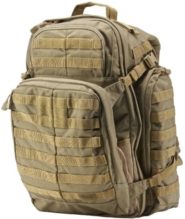
Some people decide to carry two bags, while others may decide to purchase a design where the smaller bag fits into or clips onto the larger bag.
Whatever you decide, make sure the system works for you and that you can easily separate the two kits.
You also want to make sure you are able to carry all of your supplies for long distances. I highly recommend you test it out on a hiking trail to be sure.
Your long-term bug out bag packing list will give you the tools necessary to survive without the aid of other humans or society for an extended period of time.
It should give you the ability to gain food, create temporary survival shelter and survive the elements.
Exclusive Bonus Content – Skilled Survival’s 104 Item Bug Out Bag Checklist – the only bug out checklist worth using. Click Here To Get Your FREE Copy Of It.
Foraging and Hunting Supplies
Depending on your survival skill level, you may be able to successfully fish using only a hook, some fishing line, and some rudimentary bait.
Others (who don’t live near water) may decide to learn about foraging opportunities in the local area, such as edible roots, berries, and plants.
Take your geographical location into account and pack a field guide or survival playing cards that will help you find available food.
If you’re not a hunter, include instructions on how to build traps and use snares. Of course, you will also want information on how to safely gut and prepare your kill.
If your survival books and guides are too bulky, scan and print these life-saving instructions and keep them in your bag, protected by a plastic baggie.
I recommend you carry a gun and some ammo. Obviously, guns and ammo are not lightweight items so you’ll want to be strategic. Maybe you want to include a takedown 22 survival rifle. Or maybe you want to keep things small and light with a Kel-Tec P3AT.
Whichever survival gun option you choose, just be mindful of your overall pack weight.
Caching Some of Your Long-Term Bug Out Gear
Another option to reduce pack weight is to bury a survival cache (or two) somewhere on your mostly evacuation path.
This will allow you to stock a few extras without having to carry them. You can then dig up your cache supplies for replenishment as necessary.
If you are seriously concerned about a long-term disaster situation and want to be as prepared as possible, you can always cache your gear.
For example, you can carry your short-term bag into a local park and then unearth your long-term gear while no one is watching.
If you own rural land, you can cache with more confidence than you can in public areas.
If you do decide to cache in public, make sure you do not include any personal information in your gear. You may be charged with littering if your cache is discovered, no matter how well you hide it.
 Survival Packing List Action Plan
Survival Packing List Action Plan
Planning a survival packing list is a deeply personal activity. Having both short- and long-term bags in place can help you feel secure if the unthinkable ever happens.
The ideas presented above will give you a starting point for basic survival.
As you improve your survival skills and supplies, you should add or delete items from your own survival packing list to suit your personal survival preferences.
P.s. Are you ready for the tough times ahead?
Find out now by taking my short Readiness Score Quiz – it’s absolutely free.
Once complete, you’ll know exactly where you stand on the “fragile” vs.” resilient” spectrum.
So click here to start the Quiz….And don’t worry; the questions are so easy a 3rd grader could answer them.
Click on the image to begin the Quiz and find out once and for all if you’re part of “The Fragile Masses” or “The Resilient Few.”
Top Photo Source
The post Best Survival Packing List To Plan Your Escape appeared first on Skilled Survival.


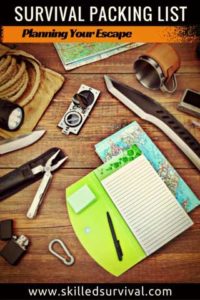

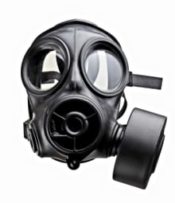
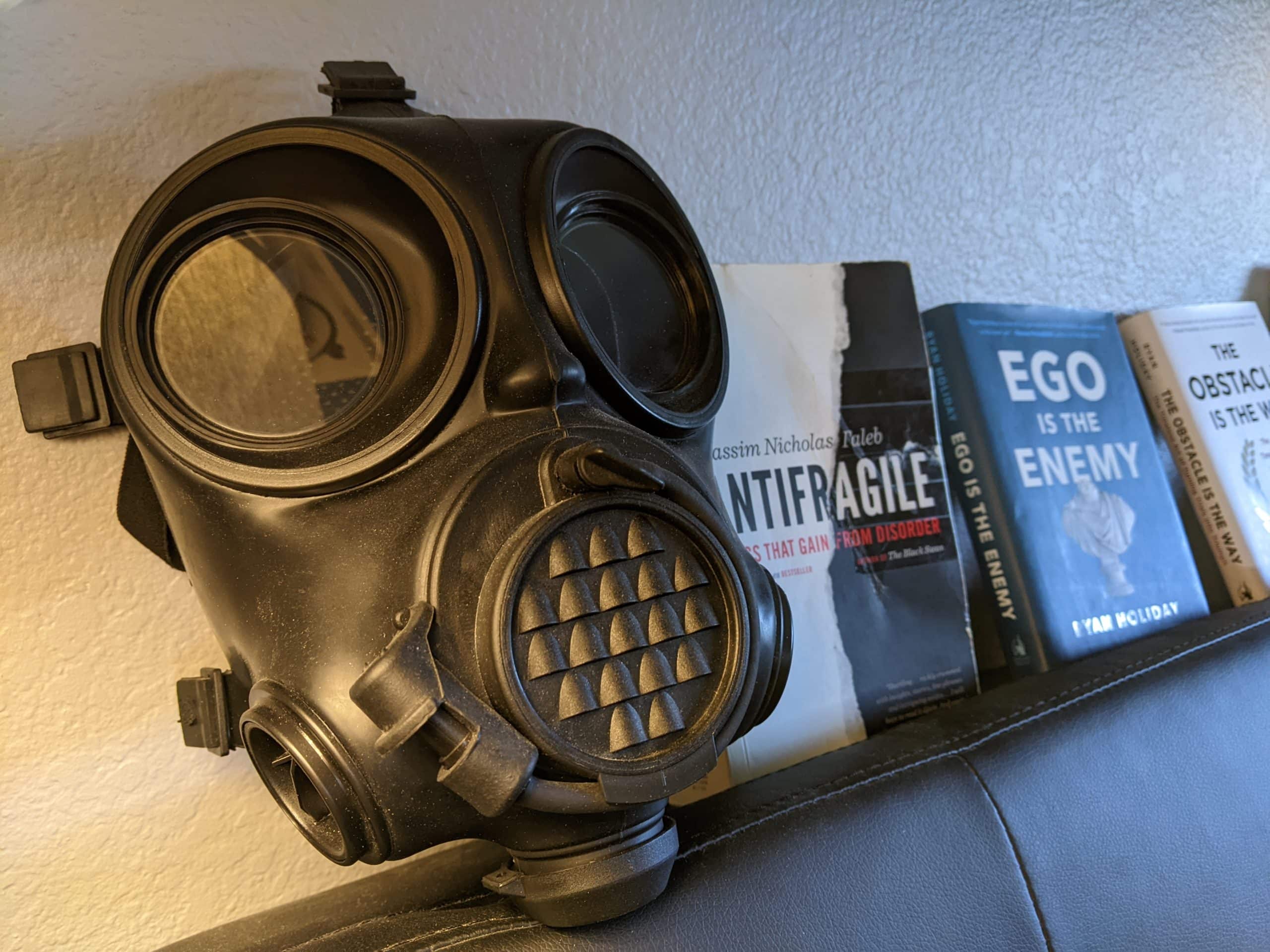

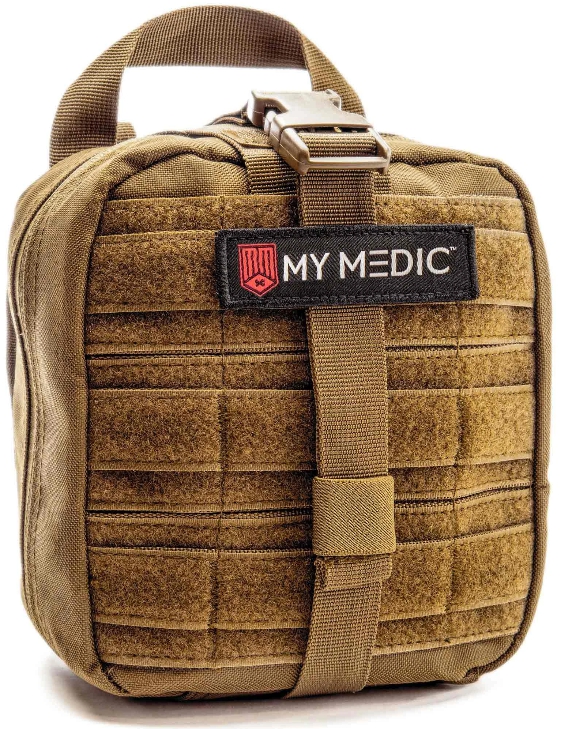
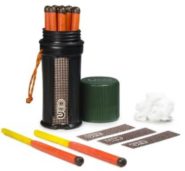

 Survival Packing List Action Plan
Survival Packing List Action Plan